Brake FAQ
#1
TECH Senior Member
Thread Starter
iTrader: (18)
Join Date: Jun 2002
Location: NW Houston, TX
Posts: 10,036
Likes: 0
Received 0 Likes
on
0 Posts

So with all the questions regarding brake upgrades lately, I thought it would be a good idea to put all the info in one place to stop new threads asking the same question from popping up everyday. One important thing to remember is that you can only stop as fast as your tires will let you.
Big Brake Kits
All of the following kits include 13 inch rotors, or optionally larger 14 and 15 inch rotors. Some of the kits also use either a 2, 4, or 6 piston caliper. These kits start as low as $240.00 and go all the way to $,3500.00+. Most of the 6 piston kits, (excpet for Wilwood) require the use of 18 inch wheels. With 14 inch rotors, 18" wheels are a must. One important thing that should be taken into consideration is the availability of replacement parts. With some of kits, you dont have much of a choice on where you can go for replacement pads and seals, so take that into account.
Brembo

Brembo is probably on of the best know brake upgrade companies. There products have came as original equipment on cars such as the Ford Mustang Cobra R, Maserati MC12, and numerous Ferrari's including the Enzo, and 575 Maranello. The Brembo F-body kit includes 330mm x 32mm two piece rotors, and a monoblock four piston caliper using 40mm and 44mm aluminum piston. The kits are available with the calipers powdercoated in either Red, Black, or Silver.
Baer

Baer is also another well known big brake company. They offer both off the shelf and fully custom kits that employ the use of 2, 4, and 6, piston calipers that are available powedercoated in many different colors. The 2 piston kits use PBR calipers (same caliper used by the C5) and come with two piece rotors, that are offered in plain, slotted, and drilled and slotted. For the four and six piston kits, Baer has recently started producing their own calipers. The older kits used Alcon calipers, with the newer ones using Baers own pieces. Reasons for the change have been said to be that Alcon couldnít keep up with the demand. The new monoblock calipers can be had in two versions, the 6S (sport) and the 6R (race). The main differences between the two is that the 6S has a cast in brace over the top of the caliper, while the 6R uses two stainless steel cross pins and spring clip for pad retention for and easier pad swap. With the 4 and 6 piston kits also comes the option for 14 and 15 inch two piece rotors (with the 15 inch using 10 inch hats).
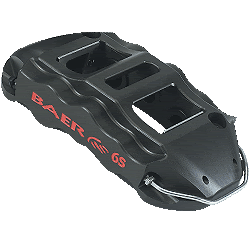
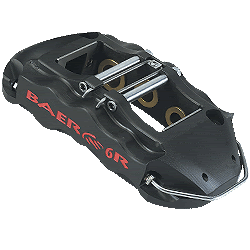
Stoptech
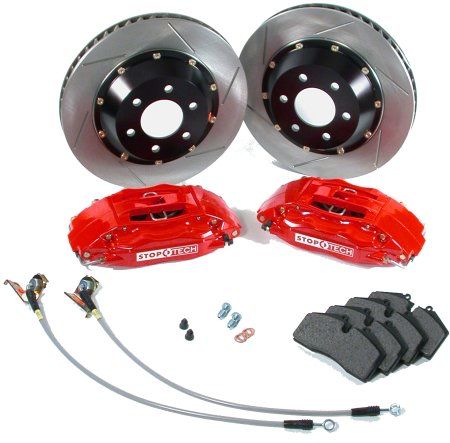
Stoptech is another company that also puts together a well thought out big brake kits for the F-body. Just for reference sake, this is the same brake company that LG Motorsports use on their World Challenge Corvettes. These kits use a 332mm x 32mm two piece rotor that is also available with options such as slotting, and cross drilling. It also uses a four piston caliper that is available in Red, Black, or Silver at no extra charge, and also in Yellow, and Blue for an additional cost.
Wilwood
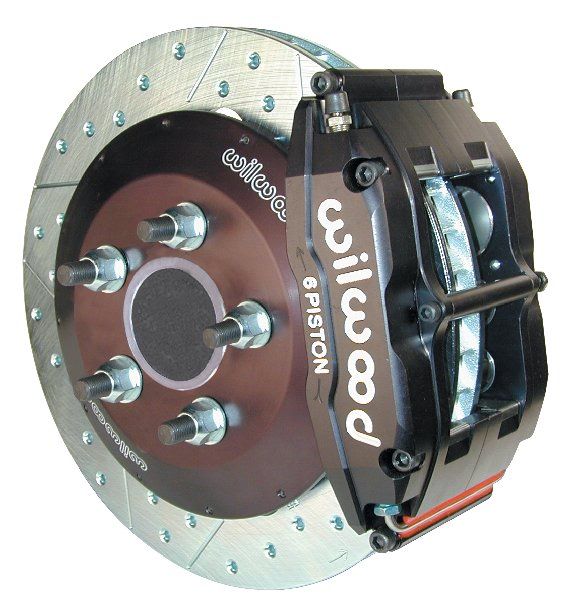
The Wilwood kit has been around for a good while now, and a number of people use this kit. One of the advantages this kit has is its possibly the only 13 inch/6 piston kit that fits under a 17 inch wheel. This kit also uses a two piece rotor that has the slotted and corssdrilled options, with aluminum hats. The calipers are a two piece 6 piston design made from billet aluminum and is available in anodized colors, also with thermal barriers to deal with heat. These calipers do not have dust boots, and are not recommended for street use, but that is up to the end user. The dust boots keep dirt, and brake dust out of the caliper and without them, the caliper will need to be rebuilt more often to prevent excessive wear to the pistons. This is also one of the few kits that require the purchase of stainless steel lines separately.
Movit
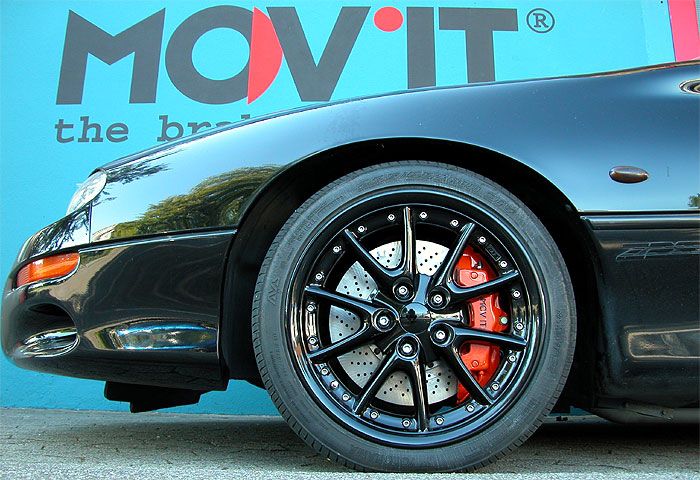
Movit is a german company that puts together big brake kits using four and six piston Porsche calipers. Up front, you have a choice of three kits, 4 pistons with a 12.6" rotor, 4 pistons with a 13.5" rotor, and 6 pistons with a 13.5 inch rotor. Movit is also the only comapny that has a kit to run the Porsche 4 piston calipers out back with a 12.6" rotor.
LG Motorsports
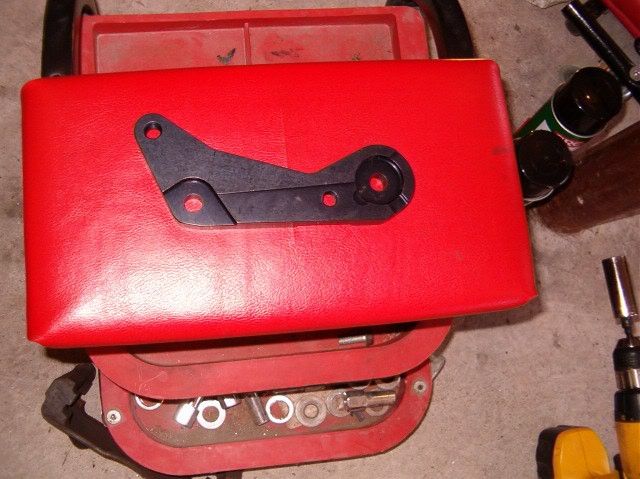
(best pic I could find)
LG Motorsports is well known in the LS1 F-body world, they were one of the first to produce a bracket that allowed the use of C5 Corvette rotors up front on the 98-02 F-body or 93-97 with 98-02 spindles. This kit is currently the only one on the market that requires no cutting of the spindles. You also have the option with this kit to retain your original gravity cast calipers, or upgrade to the stronger C5 pressure cast version. The advantage to using the C5 rotor is that itís bigger in size (12.8 vs. 11.8), the rotor is directional, and that means better cooling, also the C5 replacement rotors can be had for as low at 20 dollars each. The brackets are machined from aluminum, and are anodized black to protect against corrosion. If using the C5 caliper, this bracket also opens up your choices of pad compounds.
-Parts needed for install
Bracket
C5 Brake Rotors(2)
-Parts Recomended/Optional
Pads
Caliper rebuild kit (if using stock f-body calipers)
C5 calipers
Brake fluid
UMI Performance

UMI is a fairly new company. Their C5 bracket design is very similar to the Bob Bishop bracket, now being produced under the name Track Brackets. This kit has the same performance advantages and the LG bracket, except this bracket will fit all cars from 93-02 regardless of what spindle is on the car, but requires permanent modification to the spindle by cutting the "ears" of the spindle off. The upper ears on the 98-02 cars need to be removed, while both ears on the 93-97 cars require removal. The bracket is made from a single piece of aluminum and CNC machined into its final piece and then clear anodized for corrosion protection. UMI sells the brackets alone, or they can be had in a kit to cut down the time searching for parts.
Track Brackets/Bob Bishop Brake Brackets
These brackets are the original C5 conversion bracket. Bob Bishop sold the design, and they are now produced under the name Track Bracket. Bob Bishop has spent many hours researching different materials and differnt designs to arrive at his final product. He had these brackets put through hell and back in testing, and the design has proved more than adequate. The Original bracket was offered first in steel and then later in aluminum to shave unsprung weight. Bob has since stopped production on the brackets and the same design is now being sold under the new name "Track Brackets", only difference is that these are made in aluminum only and are anodized black. The new Track Brackets are CNC machined from a solid piece of billet 6061 aluminum.
Other Porsche Upgrades
Also there are also others who assemble kits that incorporate the use of Porsche calipers. There are limited numbers of these kits that are out there, but they are priced significantly lower than what Movit has to offer. One of the greatest advantages from this kit is the fact that you can run a 4 or 6 piston caliper, and replacement parts easily accessed at your local Porsche dealership.
Useful threads
https://ls1tech.com/forums/suspension-brakes/349232-who-has-aftermarket-brakes-baer-brembo-willwood.html
https://ls1tech.com/forums/showthrea...ight=big+brake
https://ls1tech.com/forums/showthrea...light=stoptech
https://ls1tech.com/forums/showthrea...light=stoptech
https://ls1tech.com/forums/showthrea...=1#post4369622
Useful links
Porsche brake install.
http://www.stoptech.com/tech_info/te...e_papers.shtml
http://www.c-computers.com/C5-install/
Big Brake Kits
All of the following kits include 13 inch rotors, or optionally larger 14 and 15 inch rotors. Some of the kits also use either a 2, 4, or 6 piston caliper. These kits start as low as $240.00 and go all the way to $,3500.00+. Most of the 6 piston kits, (excpet for Wilwood) require the use of 18 inch wheels. With 14 inch rotors, 18" wheels are a must. One important thing that should be taken into consideration is the availability of replacement parts. With some of kits, you dont have much of a choice on where you can go for replacement pads and seals, so take that into account.
Brembo
Brembo is probably on of the best know brake upgrade companies. There products have came as original equipment on cars such as the Ford Mustang Cobra R, Maserati MC12, and numerous Ferrari's including the Enzo, and 575 Maranello. The Brembo F-body kit includes 330mm x 32mm two piece rotors, and a monoblock four piston caliper using 40mm and 44mm aluminum piston. The kits are available with the calipers powdercoated in either Red, Black, or Silver.
Baer
Baer is also another well known big brake company. They offer both off the shelf and fully custom kits that employ the use of 2, 4, and 6, piston calipers that are available powedercoated in many different colors. The 2 piston kits use PBR calipers (same caliper used by the C5) and come with two piece rotors, that are offered in plain, slotted, and drilled and slotted. For the four and six piston kits, Baer has recently started producing their own calipers. The older kits used Alcon calipers, with the newer ones using Baers own pieces. Reasons for the change have been said to be that Alcon couldnít keep up with the demand. The new monoblock calipers can be had in two versions, the 6S (sport) and the 6R (race). The main differences between the two is that the 6S has a cast in brace over the top of the caliper, while the 6R uses two stainless steel cross pins and spring clip for pad retention for and easier pad swap. With the 4 and 6 piston kits also comes the option for 14 and 15 inch two piece rotors (with the 15 inch using 10 inch hats).
Stoptech
Stoptech is another company that also puts together a well thought out big brake kits for the F-body. Just for reference sake, this is the same brake company that LG Motorsports use on their World Challenge Corvettes. These kits use a 332mm x 32mm two piece rotor that is also available with options such as slotting, and cross drilling. It also uses a four piston caliper that is available in Red, Black, or Silver at no extra charge, and also in Yellow, and Blue for an additional cost.
Wilwood
The Wilwood kit has been around for a good while now, and a number of people use this kit. One of the advantages this kit has is its possibly the only 13 inch/6 piston kit that fits under a 17 inch wheel. This kit also uses a two piece rotor that has the slotted and corssdrilled options, with aluminum hats. The calipers are a two piece 6 piston design made from billet aluminum and is available in anodized colors, also with thermal barriers to deal with heat. These calipers do not have dust boots, and are not recommended for street use, but that is up to the end user. The dust boots keep dirt, and brake dust out of the caliper and without them, the caliper will need to be rebuilt more often to prevent excessive wear to the pistons. This is also one of the few kits that require the purchase of stainless steel lines separately.
Movit
Movit is a german company that puts together big brake kits using four and six piston Porsche calipers. Up front, you have a choice of three kits, 4 pistons with a 12.6" rotor, 4 pistons with a 13.5" rotor, and 6 pistons with a 13.5 inch rotor. Movit is also the only comapny that has a kit to run the Porsche 4 piston calipers out back with a 12.6" rotor.
LG Motorsports
(best pic I could find)
LG Motorsports is well known in the LS1 F-body world, they were one of the first to produce a bracket that allowed the use of C5 Corvette rotors up front on the 98-02 F-body or 93-97 with 98-02 spindles. This kit is currently the only one on the market that requires no cutting of the spindles. You also have the option with this kit to retain your original gravity cast calipers, or upgrade to the stronger C5 pressure cast version. The advantage to using the C5 rotor is that itís bigger in size (12.8 vs. 11.8), the rotor is directional, and that means better cooling, also the C5 replacement rotors can be had for as low at 20 dollars each. The brackets are machined from aluminum, and are anodized black to protect against corrosion. If using the C5 caliper, this bracket also opens up your choices of pad compounds.
-Parts needed for install
Bracket
C5 Brake Rotors(2)
-Parts Recomended/Optional
Pads
Caliper rebuild kit (if using stock f-body calipers)
C5 calipers
Brake fluid
UMI Performance
UMI is a fairly new company. Their C5 bracket design is very similar to the Bob Bishop bracket, now being produced under the name Track Brackets. This kit has the same performance advantages and the LG bracket, except this bracket will fit all cars from 93-02 regardless of what spindle is on the car, but requires permanent modification to the spindle by cutting the "ears" of the spindle off. The upper ears on the 98-02 cars need to be removed, while both ears on the 93-97 cars require removal. The bracket is made from a single piece of aluminum and CNC machined into its final piece and then clear anodized for corrosion protection. UMI sells the brackets alone, or they can be had in a kit to cut down the time searching for parts.
Track Brackets/Bob Bishop Brake Brackets
These brackets are the original C5 conversion bracket. Bob Bishop sold the design, and they are now produced under the name Track Bracket. Bob Bishop has spent many hours researching different materials and differnt designs to arrive at his final product. He had these brackets put through hell and back in testing, and the design has proved more than adequate. The Original bracket was offered first in steel and then later in aluminum to shave unsprung weight. Bob has since stopped production on the brackets and the same design is now being sold under the new name "Track Brackets", only difference is that these are made in aluminum only and are anodized black. The new Track Brackets are CNC machined from a solid piece of billet 6061 aluminum.
Other Porsche Upgrades
Also there are also others who assemble kits that incorporate the use of Porsche calipers. There are limited numbers of these kits that are out there, but they are priced significantly lower than what Movit has to offer. One of the greatest advantages from this kit is the fact that you can run a 4 or 6 piston caliper, and replacement parts easily accessed at your local Porsche dealership.
Useful threads
https://ls1tech.com/forums/suspension-brakes/349232-who-has-aftermarket-brakes-baer-brembo-willwood.html
https://ls1tech.com/forums/showthrea...ight=big+brake
https://ls1tech.com/forums/showthrea...light=stoptech
https://ls1tech.com/forums/showthrea...light=stoptech
https://ls1tech.com/forums/showthrea...=1#post4369622
Useful links
Porsche brake install.
http://www.stoptech.com/tech_info/te...e_papers.shtml
http://www.c-computers.com/C5-install/
Last edited by VIP1; 04-27-2007 at 08:26 PM.
#2
TECH Senior Member
Thread Starter
iTrader: (18)
Join Date: Jun 2002
Location: NW Houston, TX
Posts: 10,036
Likes: 0
Received 0 Likes
on
0 Posts

Rotors
So now we move on to brake rotors. There isnt that much to choose from out there, but it seems like every so often someone is trying to re-invent the wheel with brake rotor design.
Lets start with the 3 main types of rotors.
Plain Rotors

For braking performance, a plain rotor is the best you can get. It has no fancy holes or slots, its the best rotor to by from a performance point of view. There have been many debates on how high end race cars also use crossdrilled and slotted rotors. Heres a pic of the Murcielago R-GT's brake set up. This is a no expense spared race car BTW.
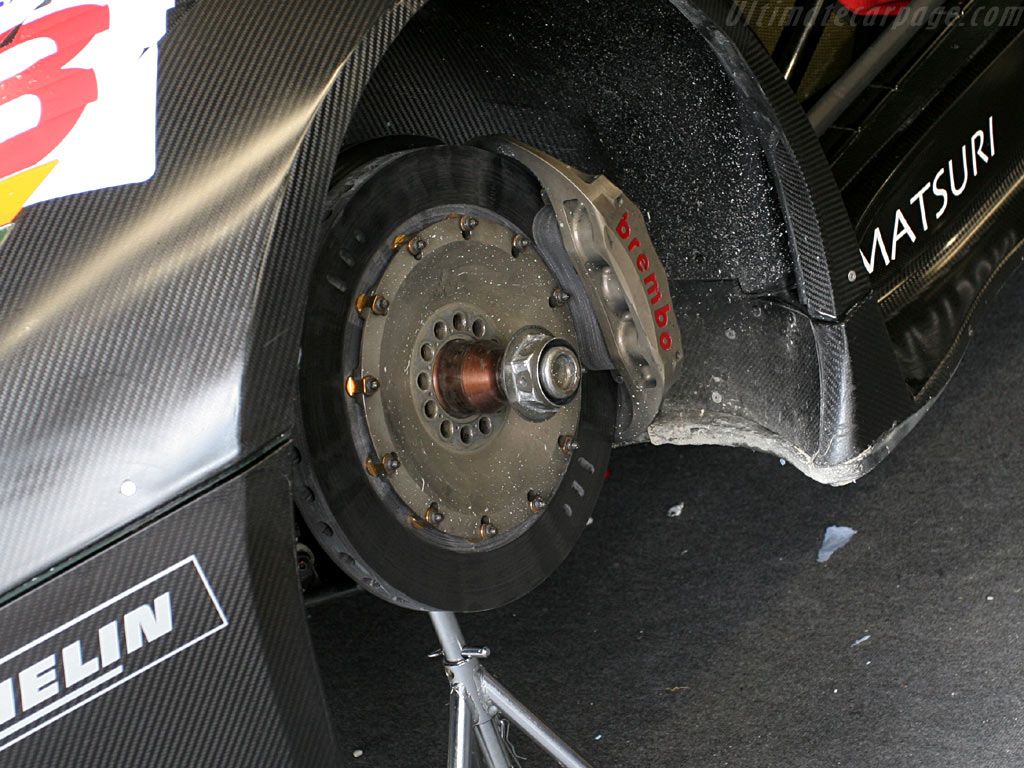
Slotted Rotors
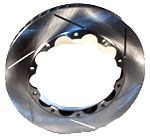
Slotts were intended to wipe away the boundary layer of gas created by older brake pads, back when pad compounds off-gassed. At the same time, slots also scrape a "fresh" surface of the pad. Now the only advantage to slots are replacing pads faster as they will QUICKLY eat through pads under aggressive driving.
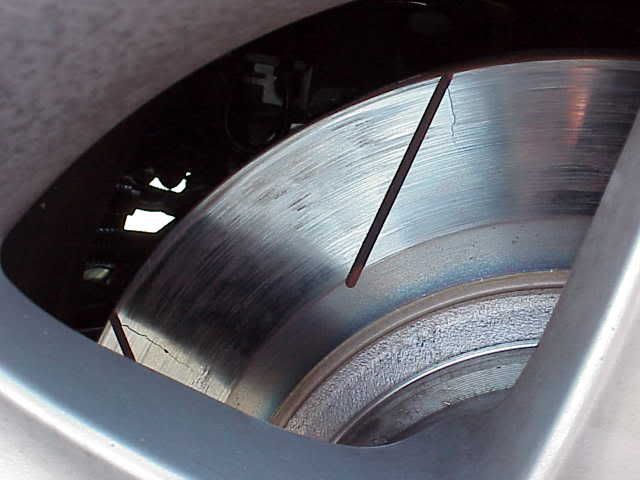
Crossdrilled Rotors
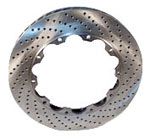
Its a common misconception that with crossdrilled rotors that they help dissipate heat faster, and allow gasses created by the friction material on pads to escape. Heres a quote from stoptechs website that should do away with that myth.
It has also been said from some rotor manufacures that with drilling holes in the rotor makes it lighter, thus reducing rotating mass, and and unsprung weight. What they dont tell you is that this weakens the rotor, and also with less mass in the rotor it reduces the thermal capacity.
You may have also heard about cross drilled rotors with the holes cast in them instead of drilled like on some of the Porsches to prevent cracking. These are the Porsche rotors in question.
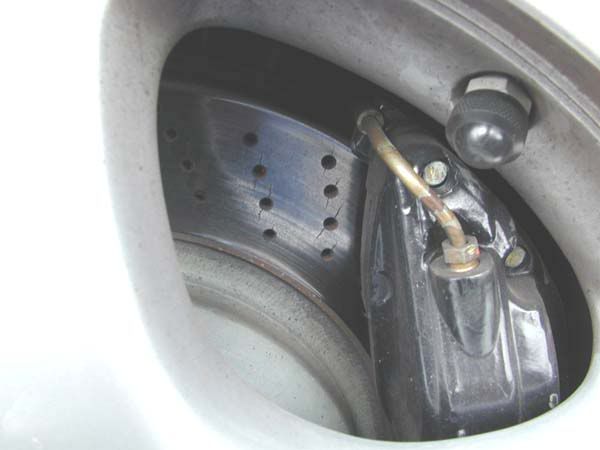
With drilled rotors and todays pad compounds, there is no performance gain to be had. It weakens the rotor, and reduces the surface area of the rotor in which the pad comes in contact with. The only purpose they serve today is to increase the looks of the assemby behind the wheel.
The original intent of drilled rotors from trackbird's site
Remember, the rotors act as a heat sink that convert the forward energy of the vehicle into heat energy through the friction caused by clamping a brake pad to the spinning rotor. Because of conservation of energy, the amount of heat created in the brakes must be equivalent of slowing down the car. That is a LOT of heat. With a reduced mass rotor, the amount of heat it can hold is also reduced. One way of increasing rotor mass is increasing the tickness of the rotor, and also by increasing the diameter. Increasing the diameter also has the bennifit of gaining additional leverage and torque capabilities.
2pc Rotors
There are a few types, the standard "T" mount style (referred to as "Bobbin float discs" in the tech link below) which are more common and a company known as AP Racing (high end, dedicated race parts, most have not heard of them) has the "strap rotor" floating design.
Here is a 2 piece floating rotor. (the last picture shows the "T" mounts and you can see the "space" the rotor has to float in...the flange is thinner than the "T"). You typically use a floating rotor with a fixed caliper (not mounted on slider pins like our stock ones are). My current Wilwoods (and all wilwoods) are a fixed caliper design, same for the Porsche conversions, etc. The problem with a fixed caliper is that any slack in the hub (which will allow the disk to wobble. This is aggrivated by large diameter rotors, the larger rotor will move more, or push the pads back more, for each degree of slack in the hub/hub bearings. It becomes a longer lever to push the pads back into the caliper.) or any heat related variation in the disk facing will push the pistons away from the disk. The next time you step on the brakes, you have to overcome that "gap" before the pads contact the rotor and begin to slow the car. If the gap (caused by what we refer to as "Pad Knockback") is excessive, you may have to pump the brakes one or more times before you will get any braking performance (not a good thing heading into a corner at 150 mph). This is why we have floating rotors. When the hub flexes or the system "moves", the rotor just floats with the caliper while the hub moves with the wheel/hub/etc. Floating rotors are not necessary with a floating mount caliper (like our stock setup on slider pins).




Here's an AP Strap rotor. (Obviously, you don't want these to get put on the wrong side of the car).


Tech information about the strap rotors is here:
http://www.apracing.com/roadcar/brakekit/stdrive.htm
They did a nice write up and it saves me lots of typing.
One bit of brilliance about the strap rotor design is it can't rattle (not that the T mounts can be heard when they are on the car, but as you handle them, they make noise) and they have far more ability to move/adjust than the T mount (which is a fixed amount of space). The straps can flex a long distance if needed.
Useful Links
http://home.columbus.rr.com/trackbir...led_rotors.htm
https://ls1tech.com/forums/showthrea...hlight=slotted
https://ls1tech.com/forums/showthrea...ighlight=rotor
https://ls1tech.com/forums/showthrea...ight=BrandonSS
https://ls1tech.com/forums/showpost....6&postcount=14
Special thanks to Garrett (pimpmaro) for his help with me getting everything organized. Also a special thanks to Kevin (trackbird) for putting together the info for the 2pc rotors.
So now we move on to brake rotors. There isnt that much to choose from out there, but it seems like every so often someone is trying to re-invent the wheel with brake rotor design.
Lets start with the 3 main types of rotors.
Plain Rotors
For braking performance, a plain rotor is the best you can get. It has no fancy holes or slots, its the best rotor to by from a performance point of view. There have been many debates on how high end race cars also use crossdrilled and slotted rotors. Heres a pic of the Murcielago R-GT's brake set up. This is a no expense spared race car BTW.
Slotted Rotors
Slotts were intended to wipe away the boundary layer of gas created by older brake pads, back when pad compounds off-gassed. At the same time, slots also scrape a "fresh" surface of the pad. Now the only advantage to slots are replacing pads faster as they will QUICKLY eat through pads under aggressive driving.
Crossdrilled Rotors
Its a common misconception that with crossdrilled rotors that they help dissipate heat faster, and allow gasses created by the friction material on pads to escape. Heres a quote from stoptechs website that should do away with that myth.
For many years most racing rotors were drilled. There were two reasons - the holes gave the "fireband" boundary layer of gasses and particulate matter someplace to go and the edges of the holes gave the pad a better "bite".
Unfortunately the drilled holes also reduced the thermal capacity of the discs and served as very effective "stress raisers" significantly decreasing disc life. Improvements in friction materials have pretty much made the drilled rotor a thing of the past in racing.
Unfortunately the drilled holes also reduced the thermal capacity of the discs and served as very effective "stress raisers" significantly decreasing disc life. Improvements in friction materials have pretty much made the drilled rotor a thing of the past in racing.
You may have also heard about cross drilled rotors with the holes cast in them instead of drilled like on some of the Porsches to prevent cracking. These are the Porsche rotors in question.
With drilled rotors and todays pad compounds, there is no performance gain to be had. It weakens the rotor, and reduces the surface area of the rotor in which the pad comes in contact with. The only purpose they serve today is to increase the looks of the assemby behind the wheel.
The original intent of drilled rotors from trackbird's site
A long time ago, pads were made with the best resins we had available. Many of those resins would produce gas as they cured. When a pad was used the first few times, the heat would "cure" the resin which would cause it to produce vapors. This was known as "out gassing". The vapors would build up between the pad and the rotor and lift or "force" the pad away from the rotor (like the puck in air hockey). This caused the brakes to be very ineffective, even though they were not yet at the maximum rated operating temperature. The holes were drilled to allow that gas a place to escape. So, it is correct to say that rotors were cross drilled to eliminate fade, but not for the reasons you would think. The good news is that today's resins no longer suffer from these problem and the modern race pads are so good that this is really no longer an issue. So, by cross drilling rotors, you will only manage to shorten the lifespan of that rotor (it now has less surface area to wear against the brake pad and will wear more quickly as well as a reduction in weight that will cause the brakes to operate at a higher temperature).
2pc Rotors
There are a few types, the standard "T" mount style (referred to as "Bobbin float discs" in the tech link below) which are more common and a company known as AP Racing (high end, dedicated race parts, most have not heard of them) has the "strap rotor" floating design.
Here is a 2 piece floating rotor. (the last picture shows the "T" mounts and you can see the "space" the rotor has to float in...the flange is thinner than the "T"). You typically use a floating rotor with a fixed caliper (not mounted on slider pins like our stock ones are). My current Wilwoods (and all wilwoods) are a fixed caliper design, same for the Porsche conversions, etc. The problem with a fixed caliper is that any slack in the hub (which will allow the disk to wobble. This is aggrivated by large diameter rotors, the larger rotor will move more, or push the pads back more, for each degree of slack in the hub/hub bearings. It becomes a longer lever to push the pads back into the caliper.) or any heat related variation in the disk facing will push the pistons away from the disk. The next time you step on the brakes, you have to overcome that "gap" before the pads contact the rotor and begin to slow the car. If the gap (caused by what we refer to as "Pad Knockback") is excessive, you may have to pump the brakes one or more times before you will get any braking performance (not a good thing heading into a corner at 150 mph). This is why we have floating rotors. When the hub flexes or the system "moves", the rotor just floats with the caliper while the hub moves with the wheel/hub/etc. Floating rotors are not necessary with a floating mount caliper (like our stock setup on slider pins).




Here's an AP Strap rotor. (Obviously, you don't want these to get put on the wrong side of the car).


Tech information about the strap rotors is here:
http://www.apracing.com/roadcar/brakekit/stdrive.htm
They did a nice write up and it saves me lots of typing.
One bit of brilliance about the strap rotor design is it can't rattle (not that the T mounts can be heard when they are on the car, but as you handle them, they make noise) and they have far more ability to move/adjust than the T mount (which is a fixed amount of space). The straps can flex a long distance if needed.
Useful Links
http://home.columbus.rr.com/trackbir...led_rotors.htm
https://ls1tech.com/forums/showthrea...hlight=slotted
https://ls1tech.com/forums/showthrea...ighlight=rotor
https://ls1tech.com/forums/showthrea...ight=BrandonSS
https://ls1tech.com/forums/showpost....6&postcount=14
Special thanks to Garrett (pimpmaro) for his help with me getting everything organized. Also a special thanks to Kevin (trackbird) for putting together the info for the 2pc rotors.
Last edited by DONAIMIAN; 11-19-2006 at 11:16 AM.


